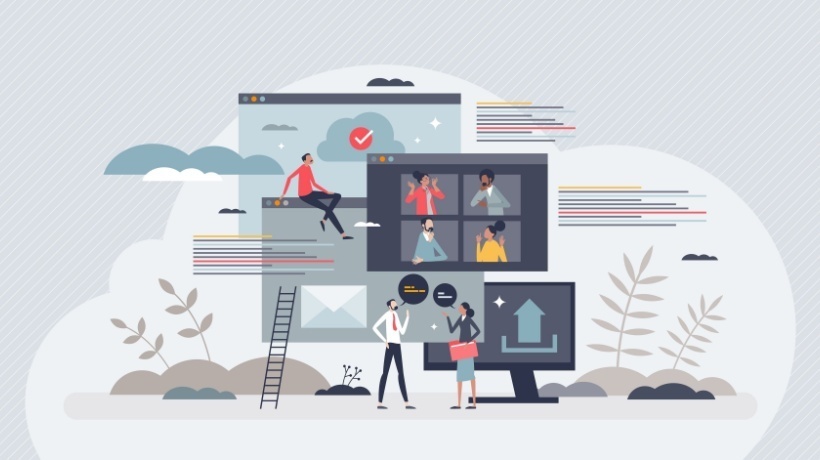COVID And The New eLearning Landscape
The COVID-19 pandemic has changed the way many of us conduct our work and lives. While some of these changes (the need for social distancing, for example) we hope to be very temporary, many of the shifts are likely to stay, such as the switch to remote and hybrid working and learning. Like all industries, eLearning has experienced significant impacts as a result of the pandemic, on the consumers and businesses who use eLearning, but also on the platforms and creators who provide it.
In this article, we will explore how the pandemic has reshaped eLearning for stakeholders throughout the industry.
eLearning: Resilient But Not Immune To COVID-19
The nature of eLearning means that, as an industry, it was more insulated than many to the early, detrimental effects of the global pandemic. For example, eLearning is conducted online, and, therefore, it is business as usual for many platforms and providers. That said, the social and economic impacts of the pandemic, more broadly, were tectonic and caused tidal waves in the supply and demand for online courses.
Let's consider each of the stakeholders in the learning value chain in isolation:
1. eLearning Consumers
The consumers of eLearning include both individuals and consumers:
Individuals
When it comes to the changes that the pandemic created for individuals, the most significant has to be time. For all of us, COVID-19 meant countless hours were spent indoors, with little to entertain us, beyond television series and social media. As the weeks dragged on, the more intellectually engaged lusted for more to do with the time created by the pandemic, which led to an explosion in demand for online educational content. In some cases, the individual adoption of eLearning might have been temporary, however, for others, it has created a lifelong habit that will outlive the pandemic considerably. There is compelling research that suggests that learning online actually increases knowledge retention by between 25 and 60%, and decreases the time it takes to learn by as much as 60% when compared with in-person teaching.
Educational Institutions
As the COVID-19 pandemic took hold, more than one billion students were forced, almost overnight, to switch from in-person teaching to learning online. Teachers had to learn, on the fly, to deliver their course content remotely, and a widespread struggle began for effective education in this new, unprecedented, teaching situation. Many educational institutions sought the support of eLearning providers to overcome many of the challenges they were facing, with eLearning being easier to manage and considered more engaging than many of the ad-hoc solutions that were initially put in place. While there will be a large-scale "return to the classroom" for these institutions, it is thought that many will retain at least some of the eLearning solutions that have been successful in the last eighteen months.
Businesses
For businesses, COVID-19 led to an unprecedented shift to remote working, which created a number of obstacles and challenges when it comes to business continuity. After all, how do you deliver vital training if employees can't attend workshops or conferences in person? And, perhaps more importantly, how do you engage, align, and empower your workforce amidst the uncertainty of the global, epidemiological situation? For many, eLearning was the solution, and businesses invested in online learning solutions more than ever before. As with individuals, there will likely be organizations that still favor in-person training once the great "return to the office" happens around the world. However, there will also be many who choose to continue with eLearning programs, owing to the many benefits of empowering people to choose how, when, and where they engage with the subject matter.
2. Content Creators
For those tasked with creating eLearning content, telecommuting was commonplace long before the global pandemic and it is no great secret that the industry as a whole relies heavily on remote, freelance contributors. However, these creators have faced significant challenges in terms of how they develop new materials, and as a result of physical restrictions on movement, have, in many cases, been unable to record any content outside of their homes. Thankfully, extensive stock footage resources are available and plugged this considerable void. Like many remote workers, these content creators also faced challenges surrounding burnout, with a huge volume of the global workforce working longer hours as a result of COVID-19.
3. eLearning Platforms
While many eLearning platforms were already accustomed to working remotely and delivering their product online, they were far from unaffected by the pandemic. Although, unlike other stakeholders in the value chain, the pandemic actually provided opportunities to eLearning platforms, which could innovate and iterate their offerings in the face of increasing demand. Platforms, such as GoSkills, which offer generous, free trials to both businesses and individuals helped introduce a new generation of users to the benefits of eLearning as they were cooped up at home, or unable to work. While some are skeptical about the longevity of this dramatic increase in demand, it is highly likely that the fallout from the pandemic is largely positive for eLearning platforms.
Post-COVID: A New eLearning Landscape
Therefore, while the eLearning industry was resilient in the face of COVID-19, there were still sizable shifts in the way that the industry as a whole operates, the impacts of which were both positive and negative and, in many cases, are here to stay. From the explosion in demand with people switching to distributed working and embracing online learning for the first time to the chance to innovate and iterate for eLearning platforms and content creators, the COVID-19 pandemic has changed the eLearning landscape forever.









